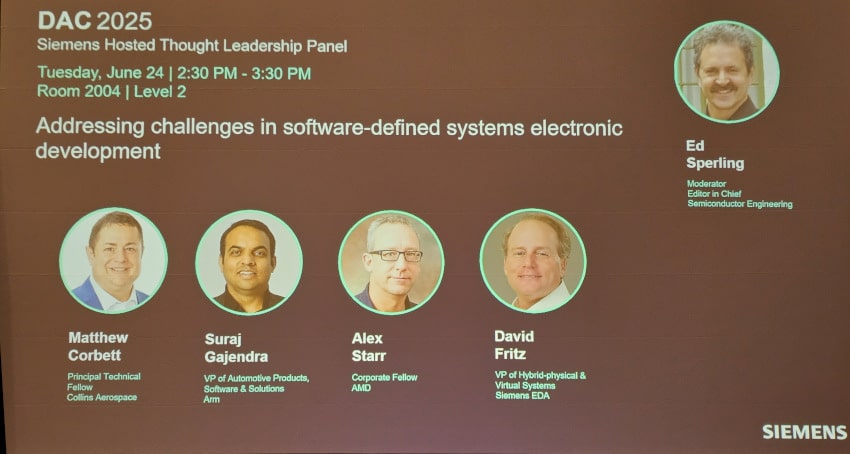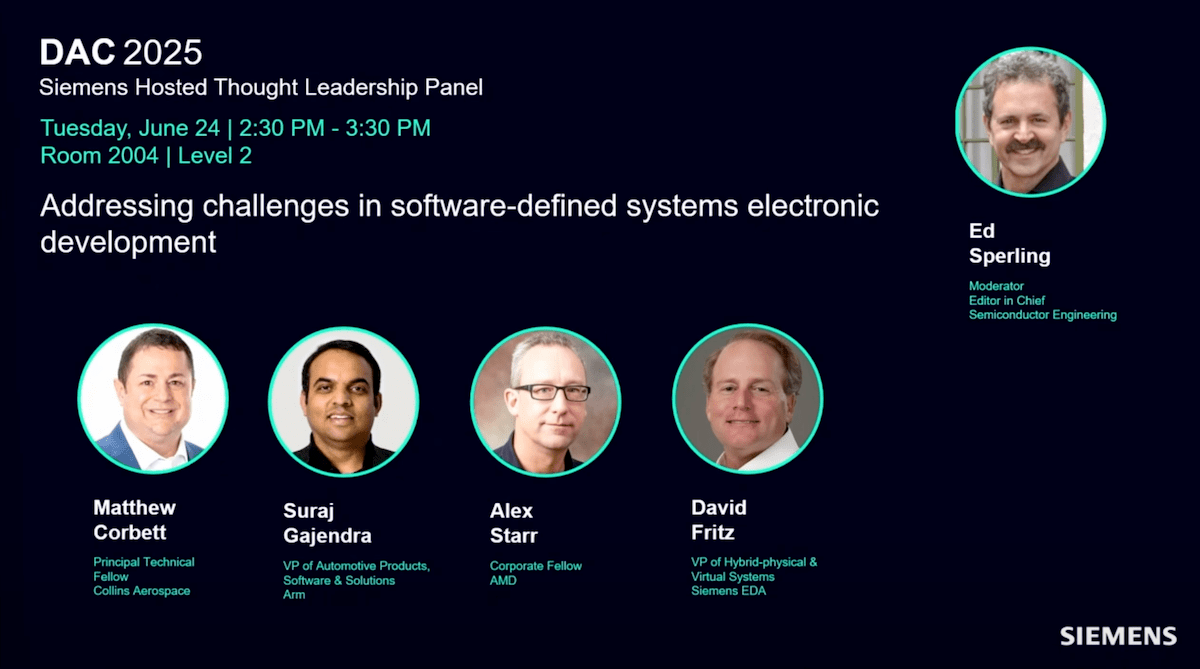Modern EVs are prime examples of software-defined systems, so I attended a #62DAC panel session hosted by Siemens to learn more from experts at Collins Aerospace, Arm, AMD and Siemens. Here’s the list of panelists that span several domains, and what follows is my paraphrase of the discussion topics.
Panel Discussion
Q: How does software-defined differ from HW/SW co-design?
Matthew – It’s really a system process vs HW/SW integration and shift left.
Suraj – For automotive using SW updates it is a SW-defined architecture, co-design is ensuring HW is aware of what SW needs to run making HW purpose-built.
Alex – The old way was to design the HW first, then the SW second. It’s more flexible to have a SW-defined approach. SW flexibility creates more verification issues.
Q: Is this different form HW/SW codesign?
David – Yes, the HW/SW 15-20 year old codesign technology is different from SW-defined, because infrastructure needs to be built for SW-defined. No more using spreadsheets and making lots of iterations, systems must be designed first and are more advanced now.
Suraj – In the automotive and aerospace domains the designs are far more complex than a laptop, so SW-defined is a different approach.
Q: How does this approach affect HW design?
Alex – For pre-silicon validation we’re using emulation and virtual modeling now. For SW-defined we’re working on SW much earlier, and doing more what-if analysis.
David – That what-if scenario is critical. Over time all systems degrade, so validating during the lifetime of the system is important. Using a SW-defined environment enables that validation.
Q: Aerospace requires critical safety, so how do they design?
Matthew – Most real-time systems use a SW-defined design approach.
Suraj – Our ARM compute IP can go into a car today, but we cannot predict how it will be used five years from now. We model the system and run much SW on that model to know if it meets requirements.
Q: How does using a SW-defined system compare on development time?
Dave – Using PAVE 360 shows how to run systems in real-time, like a vehicle that can be virtually tested, saving millions of driving miles.
Alex – With SW-defined it allows us to validate silicon early for automotive as the trend towards centralized compute vs distributed ECUs, using pre-validated silicon solutions.
Suraj – We’ve been supplying automotive IPs since 2018, and in 2021 IPs were used in developer platforms, then in 2022 for SW developers. In 2024 the IP launch also had virtual platforms and developer tools at the same time, so no more 18 month delay. All SW developers could start with new ARM IP announcements, making early validation now possible much sooner.
Matthews – The costs of designing new devices are only going up, re-spins are prohibitive in cost, so virtual platforms proves out our SW workloads much earlier.
David – You can buy ARM IP, then configure it to meet your workload needs from unknown customers. With SW-defined systems you can configure them, try workloads, then determine the ideal configuration on the first time, saving time and lowering risk.
Q: Does SW-defined effect the lifespan of new devices?
Matthew – We ask questions, like how do you provision for future workloads in 10 years from now? How many programmable accelerators do I have?
Suraj – Allowing SW upgrades in the HW increases the product lifespan and creates a stickiness to that HW platform.
Q: What kind of HW monitors are you using?
Alex – Yes, we can stream data over the system’s lifespan to inform us of their use. Pre-silicon analysis helps us guide our SW engineers on how to make things run smoothly in the field. In-silicon telemetry is important.
Q: How do you verify SW-defined changes?
David – We’ve implement a CI/CD approach with continuous validation. SW-defined requires unit testing and running emulation, then on top of that is a system level approach to put in place pre-silicon to verify the output. The PAVE 360 scenario was partially created manually and virtually, as shown in the booth. If the car is driving in the rain, does the car stop in time for safety? SW-defined products are a new way of system level verification and validation, allowing testing against requirements.
Q: Can we keep up with new developments, like in AI?
Alex – Our AI strategy is general purpose AI acceleration and bespoke edge solutions too. There’s always a newer, faster generative AI coming out in the future.
Suraj – We did an ARM release where new applications were driven by LLM requirements, so we can replace the user manual in a car with a chatbot that responds to questions. SDV infrastructure has to be in place first, then using AI apps on some NPU to run efficiently. The question is – How optimal can the workloads be run?
Alex – Our pre-silicon work is done on platforms, where data centers are built up to run new product models, even simulating a million car miles. We want that workload run in an accelerated platform in the data center for automotive market cases.
Q: How do you make backward compatibility work?
Suraj – Yes, standardization is needed to ensure backward compatibility of features. Using virtual platforms enables compatibility testing. Standardization is a must have.
David – In the traditional flow both SW and HW are bonded together, but in SW-defined they are disjoint but leveraged. Trends are shifting towards a software-defined vehicle with OTA updates in automotive. With simulation you know if the OTA update works before shipping it.
Q: Matthew, the aerospace industry has what requirements?
Matthew – For OTA updates they need to be valid and secure for aerospace use. Ensuring that the intended behavior is maintained.
Q: How does security impact systems design?
Matthew – Quick reacting to security threats is enabled by SW-defined products.
Suraj – Using a SW-defined infrastructure has security requirements, so I partition my HW and SW into a system, knowing how secure workloads are to be safely run.
Q: What does SW enabled design change?
Alex – With new products we use virtualization where components are run in separate environments, at AMD we have done this with secure workloads for a while, like in banking cases. We’re trading off how fast we can release new products vs security concerns.
Q: David, how does shift-left work with Software defined?
David – Our engineers break life down into components, so safety and security are no longer after thoughts, but thought of from the very start of a new product.
Suraj – A new car app can make payments without using your phone. OK, I gave it a try for 8 months, but it never worked, because the security standards were never met.
Q: We update phone apps, but what about your vehicle updates and multi-die systems?
Suraj – In cars the real time operations used microcontrollers that were distributed, but with new architectures they tend to have fewer and bigger compute processors, so that industry is progressing.
David – In automotive and aerospace they are bringing in new competition from overseas, so features become a factor and that new feature has to actually work in context and in the field. New business models are emerging, but errors will be made along the way, so if you can model the system in advance, that’s a benefit.
Q: What opportunities are now available?
Matthew – We can now add new features to platforms where we don’t need to pull the HW box from the airplane.
Alex – There are dramatic shifts in new features over time, enabled by modeling.
Suraj – Yes, new features and abilities are enabled, plus we can start to solve more complex problems like ADAS in automotive.
Alex – The emergence of system level modeling has benefits as complexity of vehicles increases. Using digital twin capabilities is fundamental for new systems definition.
Q: What about the challenges of new data centers?
Alex – Energy is the big problem to supply the new data centers.
David – Just using just simulation isn’t enough for data centers, so the models have to be higher level to be viable.
Q: How about aerospace challenges?
Matthew – We’re working on SW approaches ahead of real silicon being available where we can partition the architecture, then optimize for workloads.
Q: What new skills are required?
David – The smart phones have been designed with agile for a while, but automotive is. Just starting to use modern SW methodologies. Many industries do require new skill sets for systems design.
Suraj – A cross pollination across divisions within a company are required to be successful.
Alex – AMD has both SW and HW teams collaborating differently for AI projects, requiring more integration for new CI/CD cycles.
Q: With industry standards, where are we at?
Alex – Natural boundaries emerge between HW and SW standards, Chiplets with high-speed SerDes requires verifying and validating HW.
David – There’s an assumption of silicon flexibility, but not all companies are ready for that kind of design with low unit volumes. Using chiplets in combination for your new product is attractive for many industries. Using a SW-defined environment is natural for Chiplets and 3DIC usage.
Matthew – It’s a HW problem and the standards identify how the ecosystem gets built, plus you also want SW stack reuse too.
Suraj – SOAFEE is a case in point where we standardize SW foundations, and using all ARM-based SoC are consistent for security. Virtual platforms are enabled with standard SW frameworks and re-use happens quicker with standardization.
Open Q&A
Q: The automotive design cycle used to be 7 years, so what is the new design cycle?
David – With one German OEM, they asked to show us how to architect a system. In 18 months a new design was done, not in 7 years.
Suraj – China is massively changing the design scene. One customer did a first generation SoC in just 12 months. They hired 375 new people, did HW and SW design, ran pre-silicon validation, and it was18 months from concept to early production. China is not cutting corners for their design cycles.
David – We’ve visited Chinese customers and they all wrote virtual simulations. Autos are like putting wheels on a smartphone, just like another smartphone environment, so the SW-defined approach produced great results.
Suraj – In China the pace is go, go, go. We see short development cycles for Chinese automotive as the new drivers.
Alex – The progress in system design have gone from having CPUs, to multi-cores, to 256 cores, bigger caches, adding AI engines, laptops with many CPUs. The system complexity in laptops is insane. With SDV and data center modeling, expanding systems from single chip to whole systems, we see new methodologies with ever shorter design times under a year.
Summary
To watch the complete 1 hour video, view on YouTube.
Related Blogs
- Revolutionizing Simulation Turnaround: How Siemens’ SmartCompile Transforms SoC Verification
- Siemens EDA Unveils Groundbreaking Tools to Simplify 3D IC Design and Analysis
- DAC News – A New Era of Electronic Design Begins with Siemens EDA AI
- Siemens EDA Outlines Strategic Direction for an AI-Powered, Software-Defined, Silicon-Enabled Future








Comments
There are no comments yet.
You must register or log in to view/post comments.